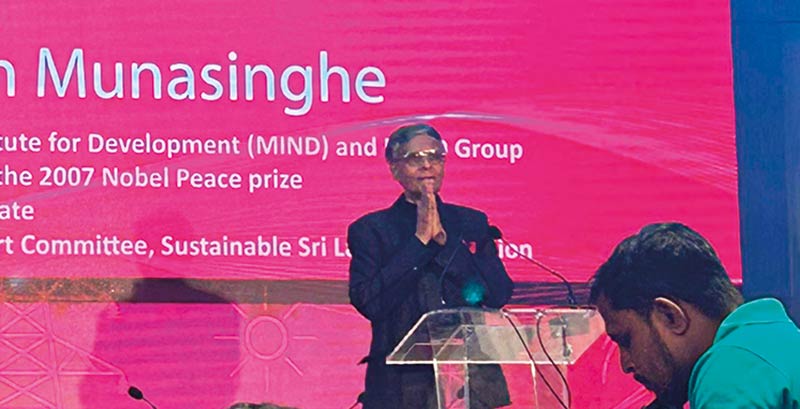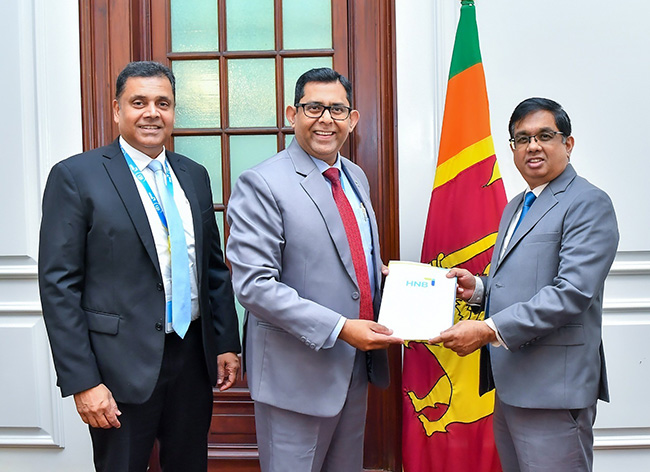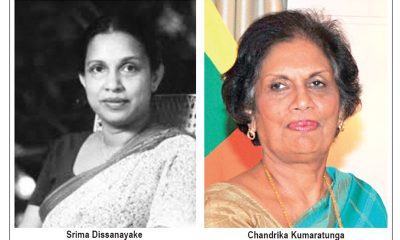Business
Transitioning to Green energy seen as vital for sustainable development in SL

By Ifham Nizam
In a significant move towards sustainable development, Prof. Mohan Munasinghe, former Vice Chair of the Intergovernmental Panel on Climate Change (IPCC) and co-recipient of the 2007 Nobel Peace Prize, emphasized the urgent need for Sri Lanka to transition from fossil fuels to Green energy.
Prof. Munasinghe’s remarks were made during the launch of the National People’s Power (NPP) Energy Policy Framework titled “Energizing the National Renaissance,” held recently at the Courtyard Marriot in Colombo.
Prof. Munasinghe, a key figure in global sustainable development discourse, warned against continuing on the current path, which he described as “very risky.”
He called for a transformation of governance systems at all levels, stating that the NPP could play a critical role in catalyzing support for sustainable development by mobilizing business and civil society to work alongside the government.
Prof. Munasinghe added: ‘The Sustainable Development Triangle is one of the elements that show how Sri Lanka can take the first step towards balanced, inclusive, green growth. Sri Lanka is at a crucial juncture and must act now to ensure a safer and more secure future.
‘Sustainable development is the major challenge for humanity in the 21st century. At the 1992 United Nations Earth Summit in Rio de Janeiro, we proposed the first principle for making global development more sustainable.
‘It is important to integrate the Sustainable Development Triangle, which includes three key elements—economy, society, and environment—into national policy. This approach is at the core of the 17 Sustainable Development Goals (SDGs), which Sri Lanka endorsed in 2015.
‘Energy is one of these goals, but it is critically linked to all the other 16. It demands an integrated approach that addresses all problems together’.
Prof. Munasinghe lauded the NPP Energy Policy for building on this framework, positioning Sri Lanka on a path towards what he described as “balanced, inclusive green growth.”
The event also saw the participation of NPP leader Anura Kumara Dissanayake, who echoed Prof. Munasinghe’s sentiments by emphasizing Sri Lanka’s potential in harnessing renewable energy resources such as wind and solar power. Dissanayake highlighted that the NPP’s energy policy aims to reduce the nation’s reliance on oil-based electricity generation and envisages transitioning to a green economy.
Business
David Pieris Group expands global footprint with investment in Dubai-based Navire Logistics

The David Pieris Group continues to strengthen its international presence with the acquisition of 50% ownership in Navire Logistics Services L.L.C, (www.navirelogistics.com) a reputed logistics company based in Dubai and Oman. This strategic move marks a significant milestone in the Group’s journey towards expanding its operations beyond Sri Lanka and positioning itself in the international markets.
In Sri Lanka, the Group’s logistics arm, D P Logistics (Private) Limited (DPL), has already established itself as a comprehensive logistics solutions provider — covering warehousing, transportation, freight forwarding, project logistics, inland distribution and custom house brokering.
DPL currently ranks among the top ten players in warehousing and 3PL operations and holds one of the largest container fleets amongst the logistics companies in the country. Despite operating in a highly fragmented freight forwarding market, DPL continues to capture a growing share, reinforcing its reputation as one of the very few local companies with expertise across all logistics disciplines.
David Pieris Group also acquired in 2022, Pulsar Shipping Agencies (Pvt.) Limited, the shipping arm of Expolanka Holdings PLC to expand its Logistics & Shipping Cluster into ship agency, husbandry services and marine logistics.
Leveraging this strong domestic foundation, DPL has now extended its capabilities to the international stage through its partnership with Navire Logistics Services L.L.C. The company’s expertise in custom house brokering, freight forwarding, cargo consolidation, warehousing, and transport solutions will be integrated into Navire Logistics’ operations, enhancing service quality and efficiency across the Middle East and South Asia.
The investment also extends to operations in Oman through a fully owned subsidiary, with further expansion plans already underway to establish operations in Saudi Arabia, Thailand, and India — strengthening the Group’s regional logistics network.
Business
HNB strengthens national response to Cyclone Ditwah

HNB PLC has contributed of Rs. 100 million towards the Rebuild Sri Lanka Fund, reinforcing its commitment to national recovery efforts following the devastation caused by Cyclone Ditwah.
“On behalf of HNB, I wish to convey our solidarity with all our fellow Sri Lankans, especially those severely affected by Cyclone Ditwah. As a home-grown institution, our connection to the communities we serve runs deep. Many of our customers and colleagues have been directly or indirectly affected, and we are committed to standing with them during this difficult time and supporting them as they rebuild.”
“HNB’s contribution to the Rebuild Sri Lanka Fund is a sign of our commitment to this collective mission. We recognize that this is going to be a long and challenging process, but we stand ready and committed to support both the immediate and long-term recovery effort,” HNB Managing Director/ CEO, Damith Pallewatte stated.
Complementing its direct financial support to the Fund, HNB has also launched a nationwide disaster relief initiative as the first phase of a broader, coordinated response from the bank.
As part of the program, the Bank donated over 2,500 essential relief and nutrition packages to support displaced families, with the consignments formally handed over to the Sri Lanka Army to ensure structured, transparent, and equitable distribution across the impacted areas of Kandy, Gampaha, Kaduwela, and Hanwella, while separate packages were provided to affected employees to strengthen their personal recovery.
Business
ComBank ranked No 1 in Business Today’s Top 40 for 2024–25

The Commercial Bank of Ceylon has been ranked No 1 in the Business Today Top 40 for 2024–25, reaffirming its position as Sri Lanka’s best-performing bank and one of the country’s top five strongest corporate entities for the 17th consecutive year.
Business Today assigned the Bank an aggregate score of 37.65, placing it at the top of its latest ranking of leading Sri Lankan enterprises.
In its presentation of the rankings, Business Today described Commercial Bank as “a beacon of resilience and renewal after a defining year,” noting that 2024 was shaped by strategic transformation, disciplined execution, and unwavering commitment to long-term sustainable growth. The publication recognised the Bank’s strength across key business lines, its deepened customer focus, and a performance trajectory that reinforced its reputation as Sri Lanka’s most resilient and customer-centric financial institution.
Reflecting on the ranking, Mr Sanath Manatunge, Managing Director/CEO of Commercial Bank said: “Being ranked No 1 in the Business Today Top 40 is a powerful endorsement of the discipline, resilience and purpose with which we steered the Bank through a year of tough conditions and decisive transformation. Our performance in 2024 was defined by navigating turbulence without losing sight of our priorities: strengthening fundamentals, supporting customers, and preparing the institution for long-term growth. This ranking is not merely an award; it is confirmation that our strategy is delivering results and that the Bank is firmly positioned to contribute to national progress with renewed confidence.”
Business Today also highlighted the Bank’s record-breaking financial performance during the year. The magazine quoted Mr Sharhan Muhseen, Chairman of Commercial Bank as saying that the Bank had delivered the highest profits in its history, and attributing this outcome to a disciplined focus on efficiency, digital innovation, and customer-centred transformation. These qualities, the publication stated, enabled the Bank to strengthen its market position and make meaningful contributions to economic recovery.
Among the milestones recognised were an equity capital infusion of Rs. 22.54 billion through a rights issue and the raising of Rs. 20 billion in Tier II capital via a debenture issue.
-

 Midweek Review4 days ago
Midweek Review4 days agoHow massive Akuregoda defence complex was built with proceeds from sale of Galle Face land to Shangri-La
-

 Features7 days ago
Features7 days agoWhy Sri Lanka Still Has No Doppler Radar – and Who Should Be Held Accountable
-

 News3 days ago
News3 days agoPakistan hands over 200 tonnes of humanitarian aid to Lanka
-

 News3 days ago
News3 days agoPope fires broadside: ‘The Holy See won’t be a silent bystander to the grave disparities, injustices, and fundamental human rights violations’
-

 Latest News7 days ago
Latest News7 days agoLandslide early warnings in force in the Districts of Badulla, Kandy, Kegalle, Kurunegala, Matale, Nuwara Eliya and Ratnapura
-

 News4 days ago
News4 days agoBurnt elephant dies after delayed rescue; activists demand arrests
-

 Features7 days ago
Features7 days agoSrima Dissanayake runs for president and I get sidelined in the UNP
-

 Editorial4 days ago
Editorial4 days agoColombo Port facing strategic neglect












